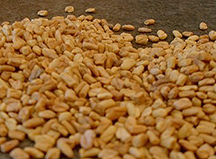
Other articles you might enjoy:
2. Saffron Makes White Rice Exquisite
3. Nifty Herb and Spice Gadgets
Make the most of culinary herbs and spices.
All About Fenugreek
by Sandra Bowens

As if the name fenugreek isn't odd enough, the substance found in its seeds, diosgenin, is proving to be quite the medical marvel. Diosgenin, also found in wild yams, has been used for years in the production of steroids. But that is the science side of spices, use your favorite search engine to find out more. We're in this for the food.
Few people outside of the Middle East are even familiar with fenugreek today. This member of the legume (beans) family, Trigonella foenum-graecum, is actually one of the oldest cultivated plants. References to fenugreek were found in records from Egyptian tombs and it was sown as oxen feed in the second century B.C.
Early Romans called it "Greek hay," the meaning of foenum-graecum in the Latin name, because they bought this common clover-like fodder from Greece. Trigonella means "little triangle" because the small off-white flowers are triangular. Fenugreek is sometimes called "goat's horn" because the seed has a horn shape.
The plant is indigenous to western Asia and southeastern Europe but it is cultivated throughout the Mediterranean, India and Northern Africa. India and Morocco are major exporters.
If the name is unfamiliar, you may assume you have never eaten fenugreek. Most likely you have; it is a common ingredient in curry powders. An extract of the seeds is also used commercially in artificial flavorings such as vanilla, caramel, butterscotch and especially maple.
The taste of the spice is somewhat like burnt maple, sweet yet bitter with a hint of celery. In addition to curries, fenugreek will enhance meats, poultry and vegetables. Too much of it will cause foods to become bitter, however, so use with caution until you become familiar with it.
Fenugreek, whole or ground, is common to Middle Eastern and African cooking. Approximately twenty of the flat light-brown seeds grow in pods that should be dried before using as they are not tasty in the raw state. Fenugreek is often marketed already ground. Look for it as a specialty spice from most purveyors.
Few recipes call for fenugreek but you might find it interesting to experiment with the next time you make a pot of beef stew or grill some vegetables. Below is a recipe to get you started.
Fenugreek Stuffing
Serve this subtly sweet yet somewhat spicy side dish with any roasted meat or poultry or to enhance a vegetarian menu.
3 Tablespoons butter
1 small onion, minced
1 stalk celery, minced
1 teaspoon plus 2 pinches ground fenugreek
4 slices toasted stale white bread, cubed small
1 Granny Smith apple, peeled, cored and diced
1/2 cup chopped toasted pecans
1/2 teaspoon salt
1/8 teaspoon freshly ground black pepper
1 egg
1/2-1 cup chicken stock
Preheat oven to 400 degrees. Coat a baking dish (see notes below) with butter or non-stick spray.
Melt the butter in a medium skillet over medium-high heat. Add the onion, celery and the two pinches of fenugreek. Cook, stirring occasionally, until the onions just begin to brown, about 8 minutes. Remove from heat; set aside to cool a bit.
In a large bowl combine the toast cubes, apples, pecans, 1 teaspoon fenugreek, salt and pepper, the egg and the reserved cooked vegetables. Add 1/2 cup of the chicken stock, mix in well and then continue adding the remaining stock until you have the desired texture (see notes below).
Transfer the stuffing to the prepared baking dish and bake about 20-25 minutes, depending on the pan you have chosen and degree of crispiness you desire (again, see notes below).
Cook's notes
Stuffing seems to be one of those intense personal taste dishes. Some like it dry and crispy while others demand serious moistness. This recipe addresses the matter in two ways. You control the moistness with the amount of chicken stock you choose to add. The texture you have in the mixing bowl is essentially the same as after you bake it, only firmer. You can control the dry and crispy part by the baking dish you choose. The more surface area exposed to heat, the more crispy stuffing you will have. If you use a very wide dish, keep an eye on your stuffing after about 15 minutes in the oven.
Of course, you can also make everyone happy by using the stuffing in the traditional way, stuff it into a bird and bake the rest in a dish on the side!
Fenugreek Links
Should you embark on a search engine search of fenugreek, don't forget--many of the sites you find are trying to sell fenugreek and may be overstating the health benefits. Here are a few links that are information without the sales pitch.
Student wins scholarship to MIT with paper patent.
Fenugreek Science and Safety from the National Center for Complementary and Alternative Medicine.
Sloan Kettering Hospital's Cancer Center information about fenugreek.
Here's one that's full of our favorite recipes because we wrote the book! It is also full of information, helpful hints and ideas for using herbs and spices in your kitchen.
Start with coriander, cumin, mustard, cayenne pepper, and turmeric, work a little magic and finish with more than fifty different, delicious Indian dishes.
Madhur Jaffrey, everybody's favorite Indian chef, shows us how to prepare authentic foods fast.
Healthy cooking at its finest, and tastiest.
Give the Mediterranean diet a try with the help of this well-organized and informative 2007 Beard Award Nominee.
Authentic yet modern Middle Eastern cooking at your fingertips and arranged in alphabetical order at that.







